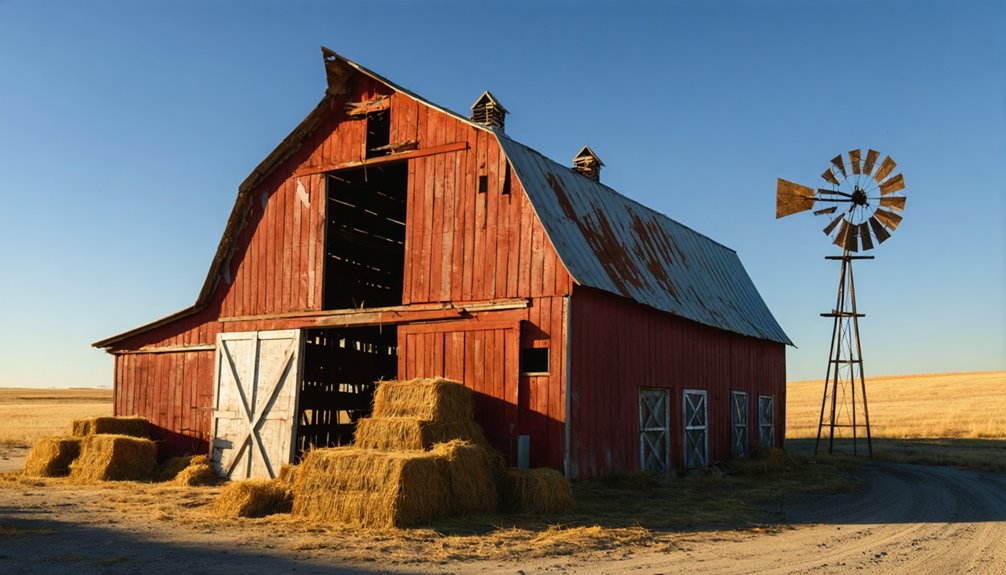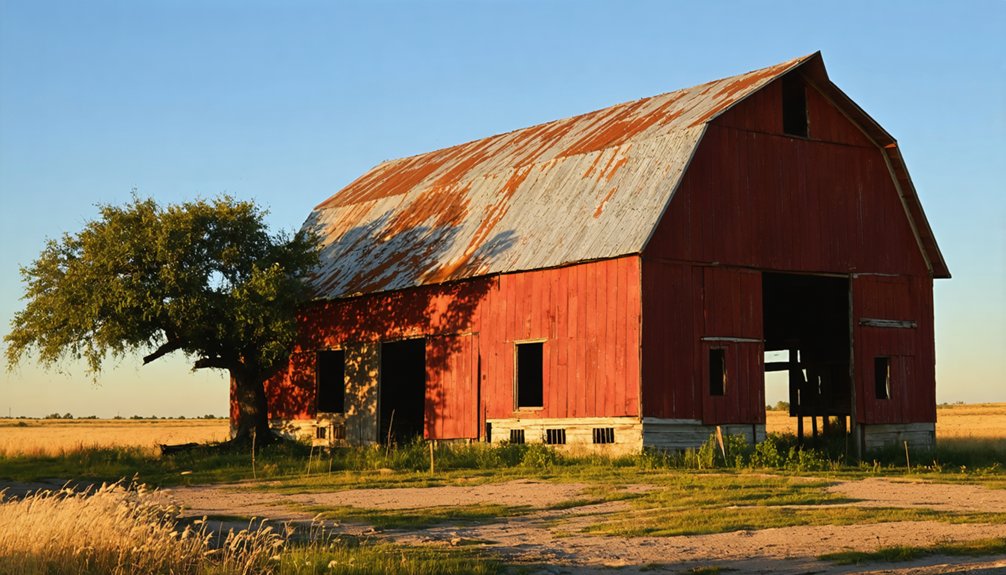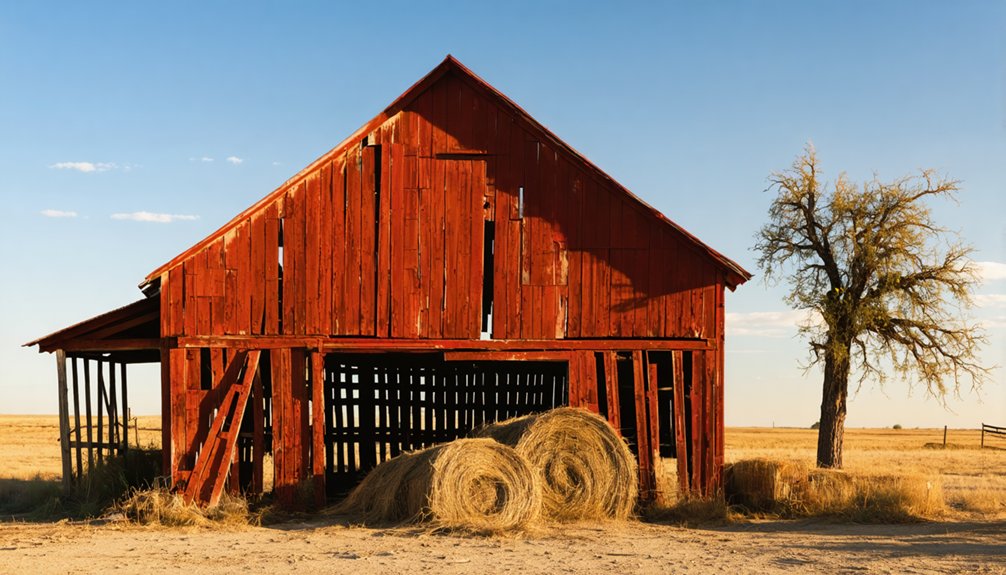You’ll find Red Barn three miles south of Iraan, Texas, where a distinctive red barn on the Yates homestead gave this oil boomtown its name. From 1926 to 1952, the community served oil field workers with basic amenities including a café, general store, and post office. The population peaked at 75 residents in 1945 before declining as oil production slowed. The town’s rich history captures a fascinating chapter of Texas’s oil boom era.
Key Takeaways
- Red Barn was a Texas oil boom town located three miles south of Iraan, named after a distinctive red barn.
- The community grew around oil field operations, featuring a boarding house, café, general store, and post office.
- Population peaked at 75 residents in 1945, with housing evolving from tents to more permanent wooden structures.
- The town’s economy relied solely on oil production, leading to its abandonment in 1952 when operations declined.
- Today, Red Barn exists only in historical records, with Texas State Historical Association preserving its oil boom legacy.
Birth of a Boomtown: The Red Barn Story
In the early days of Texas’s oil boom, a distinctive red barn on the Yates homestead became the unlikely namesake of a burgeoning boomtown in eastern Pecos County.
You’ll find this short-lived settlement just three miles south of Iraan, where it sprang up amid the region’s promising oil discoveries. The price of water reached 5 cents a cup in these bustling boom communities.
Like many who embraced the transient lifestyle of oil boom communities, workers flocked to Red Barn, drawn by the presence of a reliable water system and the economic opportunities that awaited them. The development echoed today’s Round Top Happy atmosphere that draws thousands to the area.
The town’s infrastructure struggled to keep pace with its rapid growth, yet a diverse community formed around the oil fields.
Despite its growing pains, Red Barn’s oil fields drew people from all walks of life, creating a vibrant patchwork community.
Under the influence of Ira Griffith Yates Jr., the settlement briefly flourished, transforming the dusty West Texas landscape into a hub of industrial activity.
Life in an Oil Workers’ Haven
You’d find the Red Barn boarding house buzzing with activity as workers gathered for meals between long shifts at the oil field.
The converted barn served as both shelter and social hub, where roughnecks swapped stories and shared news about drilling progress over simple but filling meals.
Living quarters were basic and crowded, yet the communal atmosphere helped workers cope with the demanding conditions of frontier oil exploration.
Many workers preferred these structured accommodations to the chaotic boomtowns that sprang up around new oil discoveries.
By 1945, the town had grown significantly as seventy-five residents called Redbarn home.
Daily Boarding House Routines
While the iconic red barn initially provided basic shelter, daily life at the Red Barn boarding house revolved around essential services that supported the oil workers’ demanding schedules.
You’d have found makeshift rooms partitioned by fiberboard, where transient lifestyles meant high turnover among residents. Workers typically stayed for two to three weeks before returning to their families. Twice-monthly paychecks kept the boarding house routines running smoothly. The discovery of the Yates oil field in 1926 brought an influx of workers seeking accommodations.
Your daily needs were met through the site’s expanding amenities. You could grab meals at the café, pick up supplies at the general store, and handle correspondence at the post office established in 1928.
The filling station kept vehicles ready for oilfield work, while the Union Chapel provided spiritual comfort. Though facilities were basic, they sustained the workforce that drove Red Barn’s economy until its eventual abandonment in 1952.
Community Among Oil Workers
Living at Red Barn meant becoming part of a close-knit yet transient community of oil workers who shaped the town’s character from its 1926 founding.
You’d find yourself among roughnecks and drillers sharing long hours at the oil fields, then gathering at the town’s café and hotel to unwind. The oil field camaraderie was evident in the way families and workers supported each other, whether you lived in one of the dozen tent homes with wooden floors or stayed at the boarding houses. Like many towns during the oil boom, Red Barn emerged as a short-lived settlement around new discoveries. Red Barn residents frequently traveled to nearby communities for bathing facilities, highlighting the town’s limited infrastructure.
Despite the rough conditions and transient lifestyles, you’d experience a unique social atmosphere where everyone from scouts to reporters mingled freely.
The general store and filling station became natural meeting spots, while the hotel and café served as the heart of daily interactions among the workforce.
Architecture and Town Layout
You’ll find Red Barn’s early architecture reflected its humble origins as an oil boomtown, with simple wooden structures and tents on wooden platforms housing the initial wave of workers and their families.
The town’s design centered around the iconic red barn-turned-boarding house, which later gave way to essential services like a hotel, café, and general store after being destroyed by fire. Today, visitors can explore these reconstructed buildings which feature creaking floorboards that add to the authentic atmosphere.
The buildings’ construction relied on locally sourced materials, including durable wood treated with homemade red paint mixtures of linseed oil combined with rust, lime, or milk for preservation.
This practice exemplified the resourceful building techniques that early Texas settlers employed when establishing new communities.
Building Materials and Methods
As Red Barn rapidly emerged during the 1920s oil boom, the town’s architectural development reflected the urgent needs of its growing population. The building techniques focused on speed and practicality, with material sourcing relying heavily on locally available wood.
You’ll find that structures evolved from simple tents with wooden floors to more permanent buildings, though all maintained a utilitarian approach.
- Original red barn’s conversion to a boarding house showcased resourceful adaptation of existing structures
- Wood-frame construction dominated the landscape, from hotels to filling stations
- Simple rectangular designs prioritized function over decoration
- Basic storefront facades incorporated wood and occasional corrugated metal
- Single-story layouts emphasized quick construction and immediate functionality
The town’s buildings, while hastily constructed, served their purpose in housing workers and supporting the bustling oil industry.
Town Planning and Design
The rapid development of Red Barn’s town layout mirrored its impromptu beginnings, with minimal formal planning guiding its growth.
You’ll find the settlement patterns centered around a converted red barn that served as the initial boarding house, establishing the heart of the community. The urban infrastructure evolved organically, with key commercial buildings – including a hotel, cafe, filling station, and general store – clustering near this central point.
In the early phases, you’d have seen families living in tents with wooden floors surrounding the commercial core.
While the town lacked formal street grids or zoning, its layout prioritized practical needs, positioning structures for easy access to work sites and essential services.
The 1928 post office establishment marked the town’s only significant institutional development.
Worker Housing Features
While Red Barn’s earliest worker housing consisted primarily of tents with wooden floors, the settlement’s architectural core emerged from a converted barn that served as the initial boarding house in 1926.
The housing evolution reflected the town’s rapid growth, shifting from temporary shelters to more permanent worker accommodations after the original barn’s destruction by fire.
- You’ll find evidence of practical, no-frills construction focused on immediate shelter needs
- Worker housing expanded from serving 25 residents in 1933 to 75 by 1945
- The community clustered housing near oil operations for efficiency
- A hotel, café, and general store supported daily life
- Basic amenities were limited, with shared facilities being the norm
These functional structures prioritized quick construction and practicality over comfort, serving the transient workforce that drove Red Barn’s oil economy.
The Decline and Abandonment

Despite its promising start as an oil boomtown, Red Barn’s decline began gradually as oil production at Yates Oil Field slowed down.
You’ll find that the town’s economic decline was inevitable due to its complete dependence on the oil industry, with no attempts to diversify its economic base.
Cultural Legacy in Texas Hill Country
Standing as a tribute to Texas Hill Country’s enduring spirit, Red Barn’s cultural legacy extends far beyond its physical structures.
You’ll find its cultural significance deeply woven into the region’s collective memory, representing a powerful blend of agricultural heritage and oil boom history.
The town’s iconic red barn, which gave it its name, embodies the resourcefulness of early settlers and the transformative impact of industrial growth.
- The barn-raising traditions reflect your ancestors’ commitment to community and cooperation
- Your connection to this heritage lives on through local storytelling and photography
- You’re part of a legacy that values hard work, neighborliness, and rural resilience
- Your history is preserved through the barn’s role as an informal museum
- You inherit the pioneer spirit that defines Texas Hill Country identity
What Remains Today: Preserving Red Barn’s Memory

Today, Red Barn’s physical presence has largely vanished from the Texas landscape, with its namesake barn and most original structures lost to time and abandonment.
You’ll find the town’s memory preservation exists primarily through historical documentation rather than physical landmarks. The Texas State Historical Association maintains detailed records of Red Barn’s role in the region’s oil boom, while historical volumes chronicle its rise and fall.
Though no active preservation efforts target the site today, you can trace the town’s historical significance through census records showing its peak of 75 residents in 1945 and archives detailing its essential services like the post office, which operated until 1952.
While the physical structures have disappeared, Red Barn’s story endures as a reflection of Texas’s dynamic petroleum heritage.
Frequently Asked Questions
Were There Any Notable Crimes or Shootouts in Red Barn’s History?
You won’t find any documented gunfight history or outlaw activity in Red Barn’s past. Historical records show it was a peaceful oil boomtown focused on worker housing and supplies.
What Happened to the Families Who Lived There After Abandonment?
You’ll find most families relocated to nearby towns like Iraan for oil work, while others spread across Texas seeking new opportunities. Their historical impact faded as they integrated into different communities.
Did Any Famous Oil Tycoons Invest in Red Barn’s Operations?
Like a forgotten wildflower in a vast field, Red Barn saw no oil investments from famous tycoons. You’ll find no Rockefeller, Getty, or Hunt connections here – just local rancher Ira Yates’ modest ventures.
What Natural Disasters Affected Red Barn During Its Active Years?
You’ll find fire destroyed the original red barn in 1926, but there’s no documented flood damage or drought impact during the town’s existence. The town avoided major natural disasters through 1952.
Were There Any Schools or Churches Established in Red Barn?
Despite having 75 residents at its peak, you won’t find any school history or church influence in Red Barn’s records. The town’s temporary nature and small population didn’t support these institutions.
References
- https://texashillcountry.com/texas-hill-country-red-barns/
- https://mix931fm.com/cherokee-county-ghost-towns/
- https://www.texasescapes.com/MikeCoxTexasTales/Grube-Texas-Ghost-Town.htm
- https://www.ghosttowns.com/states/tx/redbarn.html
- https://www.vanishingtexas.net/dorchester-texas/
- http://texasghosttowns.blogspot.com/2011/
- https://en.wikipedia.org/wiki/List_of_ghost_towns_in_Texas
- https://www.texasescapes.com/TexasGhostTowns/OddsTexas/OddsTexas.htm
- https://www.dmagazine.com/publications/d-home/2022/september-october/a-brief-history-of-the-round-top-antiques-show/
- https://www.texasalmanac.com/articles/oil-and-texas-a-cultural-history



